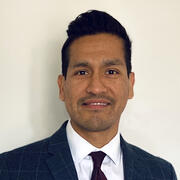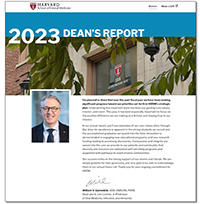
Dr. Vincenzo G. Teran joined Harvard School of Dental Medicine (HSDM) earlier this year as director of the Office of Diversity and Inclusion and instructor of Oral Health Policy and Epidemiology. He also serves as an instructor for the Department of Psychology at Harvard Medical School and a staff psychologist at the Cambridge Health Alliance. Dr. Teran shares more about what drew him to HSDM and his thoughts on creating a diverse and inclusive learning environment in the following Q&A interview.
Tell us more about your background and what appealed to you about the Director of the Office of Diversity and Inclusion role at HSDM?
I am originally from Lima, Peru and moved to the U.S. with family at a young age. Similar to most immigrant families, my parents made the tough decision to leave their home country in pursuit of a better life and educational opportunities. Growing up in the states as an immigrant and around people from different backgrounds, I developed a deep interest and appreciation for cultures. As a first-generation college graduate, I pursued this desire to learn more about the influence of culture on how we think and interact with others through doctoral studies in clinical psychology from a multicultural perspective. Taken together, these experiences have influenced my career interests and trajectory. Whether I am providing clinical services, teaching, engaging in research, or working within systems to cultivate diversity and inclusion, I rely heavily on a multicultural framework to inform my approach and practice. When I first learned about the role of Director of Diversity and Inclusion at HSDM, I recall an excitement about the opportunities the position would afford me in terms of championing diversity and inclusion efforts at a renowned academic institution. In particular, I am enthused about collaborating with the School to recruit and support future generations of multicultural healthcare leaders to work in a diverse society, while fostering an inclusive academic environment that enables all to thrive and reach their fullest potential.
What do you look forward to accomplishing in this role?
It has been well established that a diverse and inclusive learning environment is essential in promoting creativity, critical thinking, and problem-solving. Outside of academia, and in healthcare in particular, a workforce that reflects the nation’s diversity is an invaluable step towards eliminating our country’s health disparities and inequities. I am excited about working with HSDM on efforts that will propel academic excellence and help address the national health disparities and inequities simultaneously through diversity and inclusion. Prior to my arrival at HSDM, my predecessor laid a strong groundwork for many diversity and inclusion initiatives. I plan to build on these initiatives, while also being mindful of areas that require attention, implement novel approaches informed by best practices, and establish a mechanism for measuring progress and outcomes to guide the way forward. I am also interested in expanding the relationship and collaboration between HSDM with HMS and the Harvard T.H. Chan School.
The Office of Diversity and Inclusion (ODI) Student Fellows have taken an active role and interest in fostering diversity at HSDM. How can members of the HSDM community be involved in diversity efforts?
I recently had the privilege to meet many of the ODI Student Fellows and learn about their efforts at HSDM. What a talented, committed, and passionate group of students. The Office, as well as HSDM as a community, have benefitted from their excitement and involvement in raising awareness on the importance of diversity and inclusion in dental education and beyond. I am confident that their efforts will continue to inspire us to come together as a collective to learn, celebrate, stand together during challenging times, reflect on our past and critically engage with the present. In terms of involvement, while the ODI Fellowship is one of the main avenues for students to engage in diversity and inclusion projects, the Office welcomes everyone across the student, faculty, and staff bodies to join our initiatives. Some exciting projects involving the Office center around pathway programs promoting dental education to middle and high school students in Greater Boston; national recruitment efforts of URM students to join the HSDM community; and activities and programming based on diversity and inclusion topics. In the spirit of the African proverb, “It takes a village to raise a child,” it is going to require the efforts of many from our HSDM community to cultivate and nurture diversity and inclusion. I hope that you will come join us!
Why is it important for HSDM/Harvard in general to lead the way in diversity and inclusion?
As a premiere academic institution, colleges and universities look to Harvard to lead the way in many areas. When it comes to diversity and inclusion, it is no exception. Harvard is in a unique position to play a leading role in advancing institutional culture and climate of diversity, inclusion, and equity excellence through best practices. Under the leadership of Dr. John Silvanus Wilson, Jr., along with the great efforts spearheaded by leaders of various schools at Harvard serving on the Diversity, Inclusion, and Belonging Leadership Council, I am hopeful about the direction Harvard is taking in pursuing and implementing effective strategies to move the needle on diversity, inclusion, and equity. HSDM is integral to this process, and it is a privilege to represent the School and work with the University in this pursuit.
What can we do about discrimination that has arose during the COVID-19 pandemic?
Unfortunately, there has been an alarming surge of racism and xenophobia directed at people of East Asian and South Asian descent around the globe. In the U.S., according to the Asian Pacific Policy and Planning Council,” over 1,500 reports of physical and verbal attacks directed at Asians and Asian-Americans have been documented since mid-March 2020. Understandably, Asians and Asian-Americans are expressing confusion, fear, and anxiety with being out in public and the increased risk of being targeted. In times like these, it is essential for us to be an ally and stand with our Asian and Asian-American friends, neighbors, and loved ones and there are a few actionable steps we can take to do so. For one, language matters. We can be intentional about our language use, ensuring that it is line with how scientists and public health officials speak about COVID-19, and we can encourage those in our communities to do the same. Second, if someone we know has experienced a hate incident, reaching out to them to listen and validate their experience goes a long way. If appropriate, we can assist them in filing an incident report. Third, we could register for a course on intervening as a bystander. These courses typically offer concrete skills on ways to intervene and offer support without compromising our safety. Following these actionable steps as a community, we can have a meaningful impact during this challenging time.
In this current climate, how can we address broader social justice issues?
The social unrest we are witnessing unfold across the United States is painfully reminding us that there is much more to do in addressing the long-standing systemic racism and injustices still faced by Black people and communities of color. Offices such as HSDM’s Office of Diversity and Inclusion are positioned to play a pivotal role in cultivating collective consciousness on the systematic inequality that pervades our country, including our educational and health systems. However, it will take a coordinated, collective effort from all members of our community to stand against systemic racism and other injustices faced by people of color and from other marginalized identities. In times like these, let’s find strength in community and identify ways to do our part to promote and stand up for social justice.


